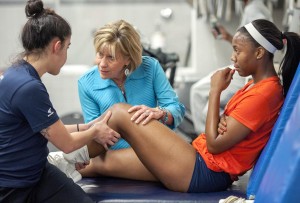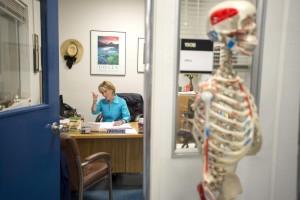Athletic Trainer Julie Max a Titan Through and Through
 The Athletic Training Clinic at Cal State Fullerton is her home.
The Athletic Training Clinic at Cal State Fullerton is her home.
“Hey, how are you?” “What’s up, how was your weekend?” “Everybody OK? Have a great day.” Julie Max’s energy fills the place, and she doesn’t let a student-athlete pass by without a few words or a hug.
“She is the mama of this ship,” assistant athletic trainer Jaime Potter said.
Known as “Mama Max,” she serves as more than Fullerton’s director of sports medicine and assistant athletics director; she’s someone students depend on for support, as she’s given as much love as instruction since she joined the Titans’ staff in 1979.
“I’m happy to be sitting here today, 35 years later, and still being able to say I love what I do,” Max said. All eyes were on Max.
As a budding student athletic trainer at Fullerton College, she became the first female student allowed to work football games.
Cognizant that every movement she made could potentially have an effect on future women entering the program, she took pride in her craft.
“She commanded respect and got respect,” former Fullerton College head athletic trainer Bill Chambers said. “Some young athletic trainers think they have to be buddies with the athletes to get respect. Julie didn’t do that. The athletes respected her because she was smart, competent and always professional.”
After transferring to Cal State Fullerton and receiving her bachelors in kinesiology in 1979, Max continued to break barriers once she began working for the university full-time.
 She became the first female president of the National Athletic Trainers’ Association in 2000, serving two terms. She was inducted into the NATA’s Hall of Fame in 2007.
She became the first female president of the National Athletic Trainers’ Association in 2000, serving two terms. She was inducted into the NATA’s Hall of Fame in 2007.
Max remains one of few female head athletic trainers at the Division I level. Division I has the highest percentage of athletics trainers of both genders, but the smallest percentage of female head athletic trainers at 19.5 percent, according to a study by R. Vivian Acosta and Linda Jean Carpenter, “Women in Intercollegiate Sport. Thirty-Seven Year Update. 1977-2014.”
Division II (31.6 percent) and Division III (42.4 percent) have higher percentages of female head athletic trainers.
“Make no bones about it, there were pressures,” Max said. “My philosophy is to first and foremost be a woman of faith, a woman of integrity, a woman of honesty. And if I run my life and my programs around that, I’m sure not to fail.”
“So I think so much of the barriers were just taking that philosophy and saying, ‘I’m going to work as hard as I can and I’m going to try to de-gender this position and see if it worked.’ And it just did.”
Every morning and night is the same for Max.
She slips into her car to leave for work and prays: “Please, dear Lord, make this be a day that we don’t lose an athlete.”
Then when she returns to her car at the end of the day: “Thank you, Lord, we got through this day without losing an athlete.”
For Max, athletic training is about saving lives; keeping athletes on the field as healthy as possible. But equally important to her is ensuring that athletes are in peak mental shape, too.
Athletes deal with a great deal of stress and even depression from the pressures of performance. As a result, Max ensures that her clinic is more than a place to get ankles taped; it’s a safe haven for athletes to feel revitalized and supported. Coaches who are yelling or being negative are not allowed to come inside.
And no matter how packed the clinic is in the afternoon, Max makes an athlete feel like he or she is the only one in the room.
“Her people skills are unbelievable,” professor of kinesiology Robert Kersey said. “There’s a lot of people in this country who have athletic-training skills that are equal to hers, I would say. But why she stands out, why she shines, why she’s an ex-NATA president, why she’s a Hall of Famer – is that combination of her clinical skills, her leadership or people skills, then her passion for athletic training and the people around her.”
In addition to her duties as director of sports medicine and assistant athletics director, Max is also a part-time kinesiology instructor at CSUF. She teaches a course on pathologies of sport injury.
Just as she evaluates herself at the end of the day, replaying the day’s events in her head, she asks her students to constantly reflect on their experiences throughout the week.
Touching base with each student, she asks: “Tell me about the scariest experience you had this week? The most exciting experience? What did you learn? What could you have done differently?”
She places her students in situations where they must think on their feet. Max said students are accustomed to being given a formula of how to do something before they can complete the task. Yet in athletic training, students must problem-solve using their own instincts, critically thinking through circumstances to find the answer.
When students make mistakes, she calmly explains to them the error and how they can improve.
“It makes a big difference, having a support system behind you, someone who actually genuinely cares about your well-being in this program,” senior athletic-training major Chris Mendez said.
Max has helped develop numerous athletic trainers who have gone on to be successful in various levels of sport. Notable alums include Ivan Pierra, head athletic trainer for the L.A. Galaxy; Nina Hsieh, head athletic trainer for the Los Angeles Lakers’ development-league affiliate, the D-Fenders; and Armando Rivas, assistant athletic trainer for the Chicago Bulls.
Witnessing students’ growth is rewarding for Max.
“You mold them, you grow them, you mentor them, you water the seed,” Max said. “You have to prune, you have to fertilize, but the greatest joy is for me to step back and see the crop.”
Athletic training is not for the faint of heart. CSUF’s staff is present at every Titan practice, home game and 95 percent of road games. The clinic closes just two days of the year – Christmas and Easter – and that hasn’t always been the case.
“We’re the only ones that are in the trenches, no matter what,” Max said.
When her staff is fatigued during a long weekend of work, Max encourages them to remain positive.
“She walks in and she just loves you up and says, ‘Dig your heads in, we got this. We can do this. This is OK,’” Potter said. “She’s that person that comes in with a smile on her face and just fires you back up.”
But as much as she inspires others, others inspire her, too.
Every year, she asks her students for feedback on how she can improve as a teacher. Ten years ago, one student suggested she “slow down and be more present” with her students, despite her demanding schedule. Since then, she’s had a post-it on her wall displaying the message.
“That never leaves me,” Max said. “Every day I look at that.”
Future generations of students will be able to share Max’ enthusiasm and passion for her work. This is the first year that Cal State Fullerton will offer the Julie Max endowed scholarship, which will provide $1,000 annually for an athletic-training student.
Courtesy of Mirin Fader, Sports Reporter, Orange County Register
mfader@ocregister.com


Comments are closed